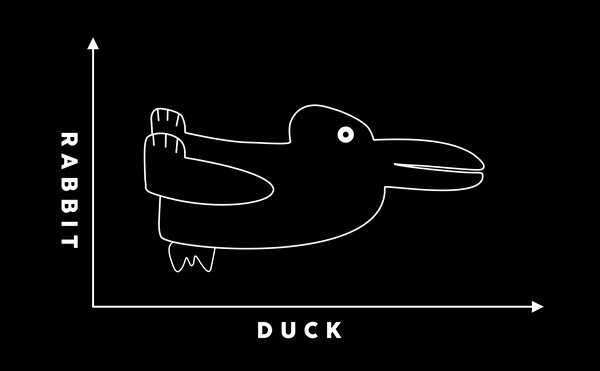You may have seen these before, images that yield two different pictures depending on how you view them. Perhaps the most common example is the duck-rabbit. When viewed from one perspective the image clearly shows the ears of a rabbit; viewed from another perspective, it shows the bill of a duck. These are known as Gestalt images, and the transition from seeing one picture to the other is known as a Gestalt switch. It requires training the eye to see the lines in the image differently to make out the two different pictures it yields.
The transition to seeing systemic racism in America requires precisely this sort of Gestalt switch. The dominant picture presented in America is one of racial equality, at least in terms of opportunity, if not ends. This is firmly rooted in the myth of the American dream: the belief that anyone can succeed if they work hard enough. This, of course, also implies the inverse: if you are not succeeding, then you are not working hard enough. In truth, there are numerous “lines” that make up this particular picture of America, and it is easy to understand why so many people of all racial and economic backgrounds see it this way. Coming to see racism as a systemic issue, then, often requires retraining our eyes to see the lines differently, to allow for a Gestalt switch in how we view America—its history and its culpability in racism.
What is a Gestalt switch?
The concept of the Gestalt originated with a group of psychologists in Austria and Germany during the early twentieth century in response to the reductionist tendencies of the time, which assumed that the best way to understand something was by reducing it to its basic parts, like a car mechanic taking apart your carburetor and putting it back together again. Instead, these Gestalt psychologists argued that in many cases, humans tend to make sense of things as a whole, in their totality, not by breaking them down. The Gestalt images were used to confirm this hypothesis.
This concept has since been applied to the disciplines of philosophy and theology.[1] However, so far as I know, it has not been used to explain the phenomenon of the failure to recognize systemic racism in America. The idea first struck me in a four-week series on Racial Injustice that I helped facilitate at my local church. Over the course of the four weeks, I found myself baffled by what, at first, appeared to be the willful resistance of the participants to accept what was being presented to them. Those of us presiding over the discussion presented an array of data regarding systemic racism in the education system, the housing system, and the criminal justice system. Still, many of the participants were either unable or unwilling to accept it. In truth, I suspect it was a bit of both. However, it began to dawn on me that it was not mere willfulness, alone. These participants had a very different picture of America in mind than the one we were presenting. It was like trying to show them that a duck is really a rabbit. It was then that I realized we had two different Gestalt pictures when discussing the same “image” of America.
Seeing systemic racism
One is the dominant picture that is presented to us on a daily basis. It is glaring as much in what it presents as what it does not. Think of The Andy Griffith Show, for example, (ancient, I know!) that presents the America of the 1960s as an idyllic place, one that many Americans long to return to. Why? A closer look at this time period does not reflect this picturesque view. The show, quite literally, whitewashes the actual history, removing any person of color and any themes surrounding issues of race, which were otherwise prominent at the time. Nevertheless, it is idealized portraits of America such as these that underlie campaign slogans such as “Make America Great Again.” They appeal to the latent belief that America is fundamentally great and would be better if we simply “got past” discussions of race and racism.
Notice, however, that this picture of America is fundamentally different from the one that acknowledges the ongoing, deeply felt, and pervasive ramifications of slavery and segregation, not to mention a host of other assumptions and practices that have been a part of America from its inception, including not only the myth of the American dream, but also the distorted theological notion of manifest destiny, the Cornerstone Speech, the Supreme Court ruling of Separate but not Equal, convict leasing, segregation and Jim Crow laws, paternalism, and so on.

Shifting our perspective between these two fundamentally different pictures of America requires something like a Gestalt switch. Those who accept the dominant picture, view the examples noted above as blips in an otherwise steady procession of American exceptionalism. They are anomalous data points to be disregarded; “things of the past” to be forgotten so we can “move on.” Making the switch, then, requires more than simply pointing out these examples, although, this is a good place to start. It requires the eye to make a fundamental leap from one picture to another, what Thomas Kuhn, a philosopher of science, has called a paradigm shift. It requires more than an aggregate of new data; it requires an entirely new way of seeing things.
Nevertheless, a good starting point often requires deliberately pointing out specific lines that distinguish, say, the duck bill from the rabbit ears. Only then can a person begin to make the shift from one picture to the other. Once the transition is made, however, it is imperative to keep the new picture prominently in mind, otherwise, it is easy to shift back into the older, more comfortable way of seeing things. This is where the onus is on those of us, like myself, who grew up accepting the dominant picture of America, to be deliberate about engaging material that presents the other picture, and, when engaging sources of the dominant narrative, to be deliberate in asking myself, “What is missing from this narrative? How would people of color see this?” Only then can I keep the new picture clear in my own thinking and behavior.
[1] See, for example, James Wm. McClendon, Jr. Doctrine: Systematic Theology Volume 2 (Nashville, TN: Abingdon Press, 1994).





